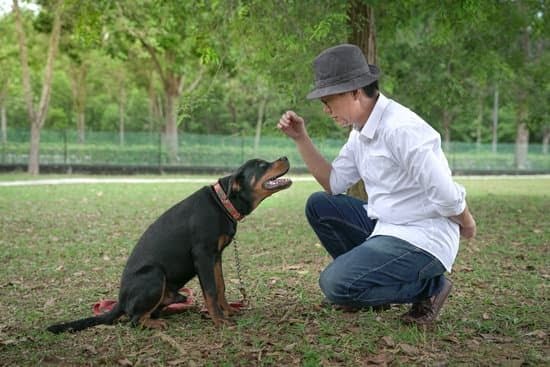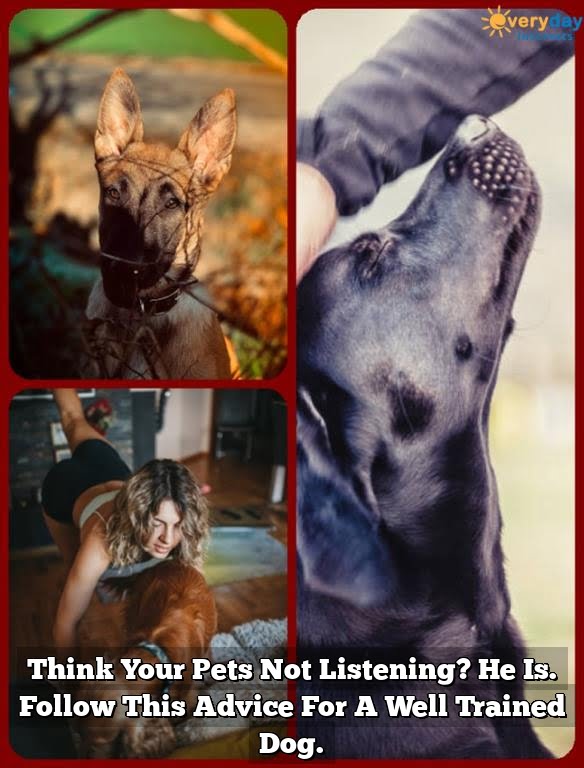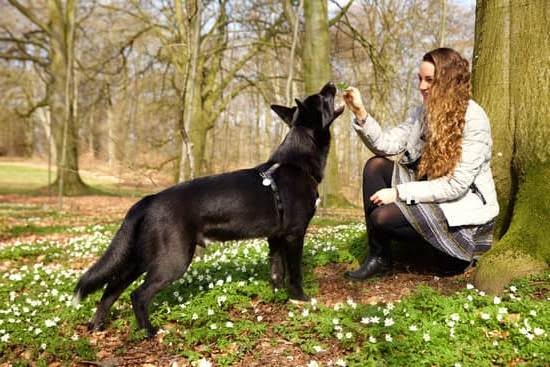Are you struggling with a dog that constantly follows you around? Do you find it difficult to get some personal space without your furry friend right on your heels?
In this article, we will explore the root causes of your dog’s behavior and provide tips on how to train them not to follow you. By understanding the behavior of dogs who constantly follow their owners, identifying the root cause of their behavior, and setting clear boundaries and rules, you can effectively train your dog to give you some space when needed.
It can be frustrating when your dog is always underfoot, but it’s important to understand the reasons behind this behavior. Dogs may follow their owners due to separation anxiety, lack of exercise, or simply out of habit. By recognizing the underlying cause of their behavior, you can address it more effectively and implement appropriate training strategies.
Setting clear boundaries and rules for your dog is essential in teaching them not to follow you around constantly. Consistency is key when establishing these guidelines, and incorporating positive reinforcement techniques can help discourage unwanted behaviors. By creating a supportive and enriching environment for your dog’s mental and physical well-being, you can promote a healthier relationship with your pet.
Identifying the Root Cause of Your Dog’s Behavior
Dogs are known for being loyal and following their owners around, but there are instances where constant following can become a behavioral issue. It is important to identify the root cause of your dog’s behavior in order to effectively address and train them not to follow you constantly.
Separation Anxiety
One of the common reasons why dogs constantly follow their owners is due to separation anxiety. Dogs with separation anxiety may exhibit behaviors such as whining, barking, destructive chewing, and following their owners everywhere. They often feel distressed when left alone and seek comfort and security from their owners. It is important to recognize if your dog’s constant following behavior is linked to separation anxiety.
Lack of Boundaries
Another reason why dogs may constantly follow their owners is due to a lack of clear boundaries. If a dog has not been taught or shown consistent boundaries and rules, they may feel the need to constantly follow their owners for guidance and direction. Understanding if your dog lacks clear boundaries will help in addressing this behavior.
Territorial Behavior
Some dogs tend to follow their owners as a way of marking or guarding their territory. This behavior can be more common in breeds that are known for being protective or territorial. Identifying if your dog’s behavior stems from territorial instincts will help in determining the approach needed for training.
By understanding the root cause of your dog’s behavior, you can create an effective training plan on how to train your dog not to follow you constantly.
Setting Clear Boundaries and Rules for Your Dog
When it comes to training your dog not to follow you constantly, setting clear boundaries and rules is essential. Here are some steps on how to train your dog not to follow you:
1. Establish consistent rules: Consistency is key when training your dog. Set clear rules for when it is appropriate for your dog to follow you and when they should maintain their distance. For example, during mealtimes or when you are busy with a task, it’s important for your dog to understand that they need to give you space.
2. Use positive reinforcement: When your dog follows the established boundaries and rules, reward them with praise, treats, or playtime. Positive reinforcement will help them understand what behavior is acceptable and encourage them to repeat it in the future.
3. Provide physical and mental stimulation: Ensure that your dog gets enough exercise and mental stimulation throughout the day. A tired and mentally fulfilled dog is less likely to constantly follow you around, as they will have other outlets for their energy and curiosity.
By following these steps and setting clear boundaries and rules for your dog, you can effectively train them not to follow you constantly. Remember that patience and consistency are key when implementing these training techniques. If you find that the behavior persists despite your efforts, don’t hesitate to seek professional help from a certified dog trainer or behaviorist.
Establishing a Consistent Routine for Training
One of the most important steps in training your dog not to follow you is to establish a consistent routine for training. Dogs thrive on routine and will respond well to consistent, predictable training sessions. By setting aside dedicated time each day for training, you can help reinforce the boundaries and rules you’ve established for your dog.
Consistency is key when it comes to training your dog not to follow you. This means using the same commands, gestures, and signals each time you train your dog. It also means maintaining consistency in your own behavior, such as always enforcing the rules and boundaries you’ve set for your dog.
In addition to daily training sessions, it’s important to integrate training into your everyday interactions with your dog. This could include reinforcing the stay and wait commands during meal times or when opening doors. By incorporating consistent training into your daily routine, you can effectively teach your dog not to follow you without relying on punishment or negative reinforcement techniques.
Using Positive Reinforcement Techniques to Discourage Following
Dogs are naturally inclined to follow their owners, but it can become problematic if they do it excessively. Using positive reinforcement techniques can help discourage this behavior and teach your dog to be more independent. Here are some effective ways on how to train dogs not to follow you.
First, make sure to reward your dog when they are not following you. Whenever your dog is walking at a distance or staying in another room, give them a treat and praise them for their good behavior. This will reinforce the idea that being independent is a positive thing.
Another technique is to use clicker training. Clicker training involves using a small device that makes a clicking sound as a signal for good behavior. For example, when your dog stays in another room or follows a command not to follow you, use the clicker and give them a treat immediately after.
It’s important to be consistent with these positive reinforcement techniques. Dogs respond well to routine and consistency, so make sure everyone in the household is on the same page when training your dog not to follow you. With time and patience, your dog will learn that they don’t need to be constantly by your side and will become more independent.
| Positive Reinforcement Techniques | Effectiveness |
|---|---|
| Rewarding good behavior with treats and praise | Highly effective in reinforcing independence |
| Clicker training | Effective in signaling good behavior and rewarding it immediately |
| Consistency and routine | Vital for long-term success in discouraging following behavior |
Teaching Your Dog the Stay and Wait Commands
When it comes to training your dog not to follow you constantly, teaching them the stay and wait commands can be incredibly helpful. These commands provide your dog with clear instructions on when they should remain in place and when they should refrain from following you.
To teach your dog the stay command, start by having them sit or lie down. Once they are in position, give the verbal cue “stay” while holding your hand out with an open palm in front of them. If they remain in place for a few seconds, reward them with a treat and praise. Gradually increase the duration of the stay before giving the reward, always making sure to use positive reinforcement.
Similarly, to teach your dog the wait command, have them sit or stand and then take a step back or away from them while giving the verbal cue “wait.” If they stay in place, return to them and offer a treat as a reward. Practice this command in various situations, such as at doors or before mealtime, to reinforce their understanding of when to wait.
Using these commands consistently will help your dog understand when it’s appropriate to follow you and when they should remain where they are. Remember that patience and consistency are key when training your dog not to follow you constantly.
| Command | Description |
|---|---|
| Stay | Tells the dog to remain in place until given further instruction |
| Wait | Instructs the dog to pause or hold back from moving forward |
Utilizing Distractions and Redirection Techniques
When your dog constantly follows you around, it can be due to a lack of mental stimulation or a strong desire for attention. Utilizing distractions and redirection techniques can help train your dog not to follow you constantly.
Providing Interactive Toys and Games
One way to distract your dog from following you is by providing interactive toys and games that require mental engagement. Puzzle toys, treat-dispensing toys, and hide-and-seek games can keep your dog occupied and focused on the activity at hand instead of following you.
Redirecting Attention With Commands
Another effective technique is to redirect your dog’s attention with commands such as “sit,” “stay,” or “go to your mat.” When you notice your dog starting to follow you, give them a command to redirect their focus onto a specific behavior or action. By consistently using these commands, you can teach your dog to respond positively without constantly following you around.
Engaging in Training Sessions
Regular training sessions that focus on obedience, agility, or tricks can also serve as distractions for your dog. These sessions not only provide mental stimulation but also help reinforce positive behaviors while discouraging excessive following. By engaging in training activities regularly, you are offering an alternative outlet for your dog’s energy and attention.
By utilizing distractions and redirection techniques, you can effectively train your dog not to follow you constantly. Remember that consistency and patience are key when implementing these strategies. With time and effort, your dog will learn to engage in other activities instead of being overly dependent on following you around.
Seeking Professional Help if the Behavior Persists
If you have tried various techniques to train your dog not to follow you, but the behavior continues to persist, it may be time to seek professional help. A professional dog trainer or animal behaviorist can provide valuable insight and expertise in addressing your dog’s persistent following behavior. They are trained to assess and understand the root cause of your dog’s behavior and can offer personalized training plans to effectively address the issue.
When seeking professional help, it is important to choose a reputable and qualified expert who uses positive reinforcement techniques and has experience working with dogs exhibiting similar behaviors. You can ask for recommendations from veterinarians, friends, or family members who have sought professional help for their pets. Additionally, researching reviews and certifications of potential trainers or behaviorists can help you make an informed decision.
During your consultation with a professional, be prepared to provide detailed information about your dog’s behavior, any training methods you have already tried, and the specific situations in which the following behavior occurs. This will allow the expert to tailor their approach based on your dog’s unique needs and environment. Working with a professional can give you the support and guidance you need to effectively address your dog’s following behavior in a safe and compassionate manner.
- Research reputable and qualified experts
- Gather detailed information about your dog’s behavior
- Be open to following personalized training plans
Creating a Supportive and Enriching Environment for Your Dog’s Mental and Physical Well-Being
In conclusion, training a dog not to follow you can be a challenging task, but with patience and consistency, it is achievable. Understanding the behavior of dogs who constantly follow their owners is crucial in addressing the issue effectively. Identifying the root cause of your dog’s behavior, such as separation anxiety or attention-seeking, will help tailor your training approach to suit your dog’s specific needs.
Setting clear boundaries and rules for your dog is essential to communicate what behaviors are acceptable and unacceptable. Establishing a consistent routine for training will help reinforce the desired behavior over time. Using positive reinforcement techniques, such as rewards and praise, can be effective in discouraging following and promoting independence in your dog.
Teaching your dog commands like stay and wait, as well as utilizing distractions and redirection techniques, can further aid in training your dog not to follow you constantly. And if despite all efforts the behavior persists, seeking professional help from a certified dog trainer or veterinarian is recommended.
Ultimately, creating a supportive and enriching environment for your dog’s mental and physical well-being is key in ensuring a happy and well-adjusted pet. By providing plenty of mental stimulation, exercise, and affection, you can help address any underlying issues that may be causing your dog to constantly follow you.
Frequently Asked Questions
How Do I Train My Dog to Stop Following Me?
The key to training your dog to stop following you is to teach them the “stay” or “go to your bed” commands. Practice these commands consistently and reward your dog for staying in one place when you ask them to.
How Do You Train Your Dog to Not Follow You Around the House?
To train your dog not to follow you around the house, establish boundaries by using a crate or baby gates. Encourage independence by giving your dog activities to do on their own and rewarding them when they remain in a designated area.
Can You Train a Dog Not to Be Clingy?
Yes, it is possible to train a clingy dog to be more independent. Start by gradually increasing the amount of time you spend apart from your dog, while also providing them with toys and treats that keep them occupied when you’re not around. Consistency and positive reinforcement are key in teaching a dog not to be clingy.

Welcome to the blog! I am a professional dog trainer and have been working with dogs for many years. In this blog, I will be discussing various topics related to dog training, including tips, tricks, and advice. I hope you find this information helpful and informative. Thanks for reading!





